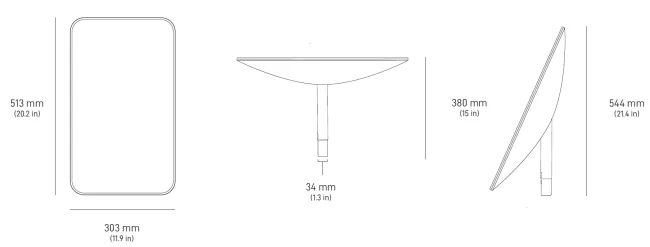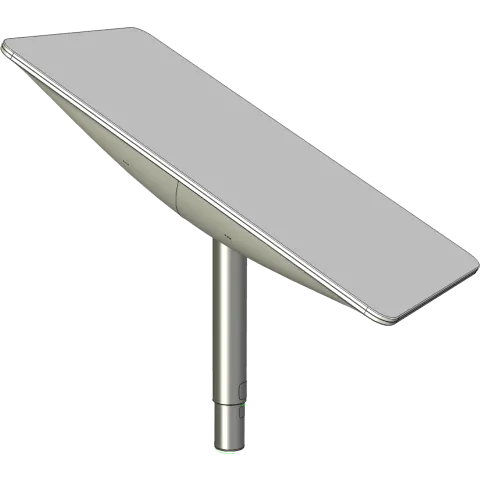Description
Starlink's Generation 2 User Terminal, known as the Standard Actuated Dish, or "Rectangular Dishy" is a satellite terminal provided by Starlink as the main user equipment between November 2021 and late 2023. The unit is referred to as the Generation 2 (Rev3) UT. Generation 1 (Rev1 & Rev2) refer to the "Round Dishy". Depending on when the UT was manufactured it may have a sub-version of rev3_proto0, rev3_proto1, or rev3_proto2.
The antenna unit UTA-212 connects to its corresponding router UTR-211. Specification here refers to the UTA-212 only.
In general, the Starlink Gen2 User Terminal is a satellite transceiver which uses digital beamformers and an Electronic Steerable Antenna to track and maintain connectivity with LEO satellites as they move overhead. Gen2 uses motors to adjust azimuth and elevation to position the phased array orthogonally (ideally 90°) to the direction of the satellite and therefore maximising the effective antenna area.
Starlink UTs communicate using the Ku-Band, receiving a 240 MHz channel between 10.7 and 12.7 GHz, and transmiting a 60 MHz channel back to the satellite between 14.0 and 14.5 GHz. While the UT is theoretically capable of up to 720 Mbps downlink (64QAM), it realistically achieves data rates to a maximum of about 360 Mbps (1.5 bits/Hz).
Information on Starlink UTs is difficult to piece together. If you notice an error please reach out to our team.
Network Interfaces
Wireless Interfaces
Starlink Transceiver
Ethernet Interfaces
| Interface | Quantity | Function | Signalling | PoE Input |
|---|---|---|---|---|
|
1
|
LAN, to UTR-211 Router
|
Antenna Specifications
Electronic Steerable Antenna
Frequency Test Data
| Start Freq. | Stop Freq. | Peak Gain | Azimuth | Elevation |
|---|---|---|---|---|
|
10700 MHz
|
12700 MHz
|
30.4 dBi
|
3.5°
|
3.5°
|
|
14000 MHz
|
14500 MHz
|
31.8 dBi
|
2.8°
|
2.8°
|
Physical Specification
Power Specifications
Drawing

Downloadable Resources
Starlink, initiated by US company SpaceX in January 2015, is a satellite network project aimed at providing satellite internet connectivity. The project's primary objective is to deliver broadband services globally, particularly to underserviced areas of the planet. Starlink's constellation comprises thousands of mass-produced small satellites, orbiting in low Earth orbit (LEO), working in ...




